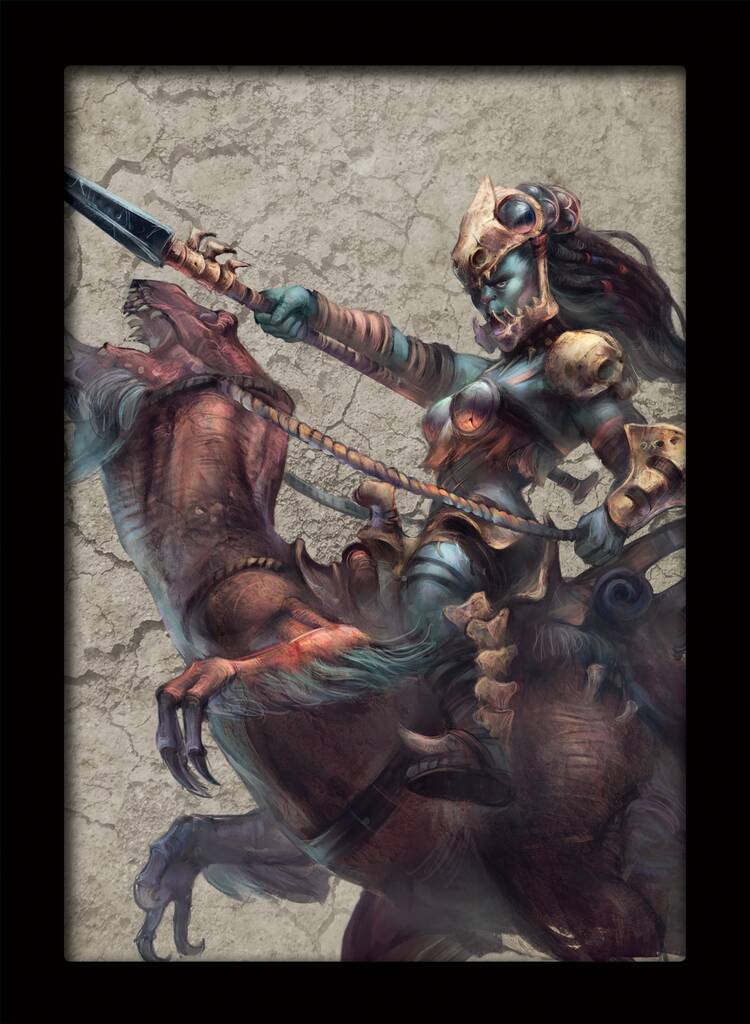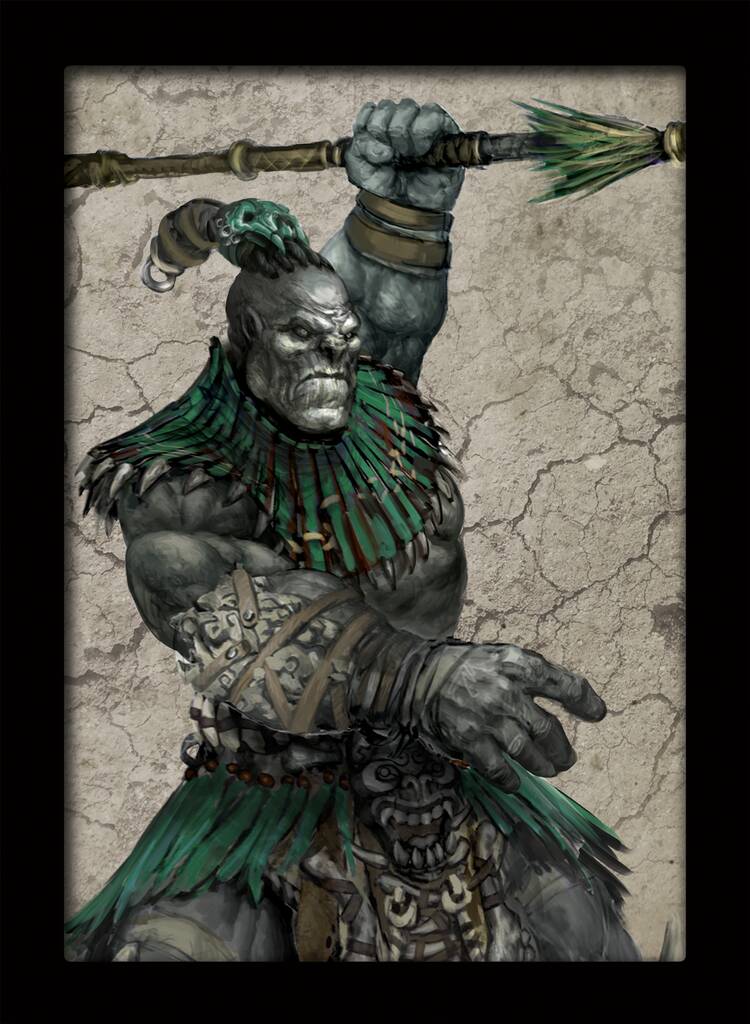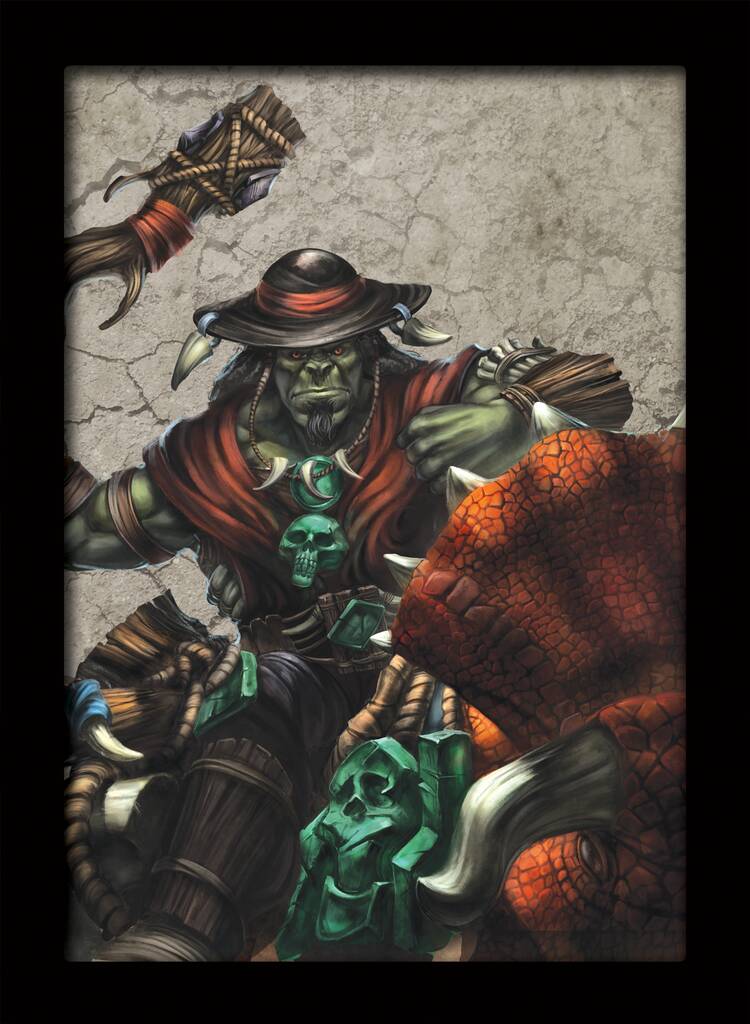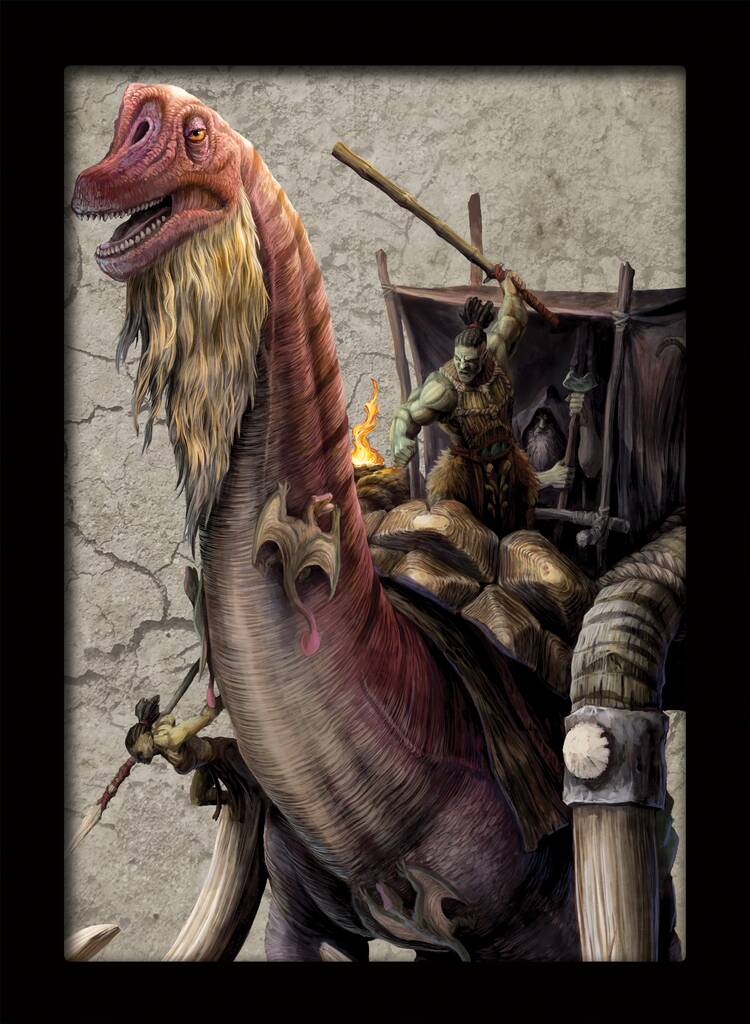W'adrhŭn

Tailored to wage war and tamers of the wildest beasts the world has ever known, the budding civilization of the tribes of the W’adrhŭn is claiming its stake in the world – and they have the means to do so.
“We are all Bound. This, Nagral of the Coati seems to forget. We are bound to the Tribe. We are bound to the Cults. We are bound to the people. We are bound to the Ukunfazane.”
– Dagrosh of the Cult of Famine

![]() The first recorded mention of the W’adrhŭn is a canto of the saga of Charles Armatellum that speaks of his peace treaty with the primitive tribes beyond the Claustrine Mountains. For centuries, the tales of nomadic savages with giant, pre-dominion beasts that dwell beyond the edges of civilization have been a source of entertainment, delight, and lazy, abstract deliberations amongst self-titled scholars and historians. The truth lies so far from these theories and witticisms as the wastelands and oases of the W’adrhŭn lie from the luxurious foyers these discussions are usually held in.
The first recorded mention of the W’adrhŭn is a canto of the saga of Charles Armatellum that speaks of his peace treaty with the primitive tribes beyond the Claustrine Mountains. For centuries, the tales of nomadic savages with giant, pre-dominion beasts that dwell beyond the edges of civilization have been a source of entertainment, delight, and lazy, abstract deliberations amongst self-titled scholars and historians. The truth lies so far from these theories and witticisms as the wastelands and oases of the W’adrhŭn lie from the luxurious foyers these discussions are usually held in.
It is perhaps understandable why the learned of humanity would be so dismissive in their views of this young race. The W’adrhŭn are indeed a fledgling civilization, one that was forced to scrap a living off the limited resources available in the Wastelands beyond the Claustrine mountains. This lack of resources has forced them into a harsh and often violent living, as different Tribes clash for sources of food or water, with equipment and attires that look near-primitive in the eyes of the civilized Kingdoms. Such abstract descriptions are vaguely known by the learned elite. It is also known to them that the W’adrhŭn are “just another” creation of the Spires; therefore, they are conceived much like the witless drones the Exiles throw onto the field of war to die at their masters’ convenience or the terrifying, mindless abominations they have unleashed upon the world. But unlike prior attempts and creations, the W’adrhŭn were never meant to supplement the retinue of monsters, killers, and expendable troops fielded by the Spires. They were meant to be a race of true warriors, an unstoppable vanguard force capable of securing the Reclamation of the Exile homeland and ensuring the Directorate’s dominance on Eä once this mission was accomplished.
To create the W’adrhŭn, rather than work on the basis of Exile strands, the Biomancers of the Spires sought to decipher the weaves of countless donor species that presented the desired characteristics in order to replicate their features on a completely new and hybridized structure. While series upon series of creations proved failures, unable to “quicken” into awareness, one day, for no understandable reason, no discernible metric, the bodies of two breeding pairs woke within minutes of each other, their physical capacity far exceeding original expectations. Some would later attribute the outcome to the strands of humanity weaved into their design. Others would speculate that the regenerative abilities of echinoderms or reptiles were responsible; such strands had been mixed in the many different attempts to urge quickening with insufficient research about the possible mutations they could trigger. Others still would attribute the awakening of the Four to the powerful, perhaps too much so, primeval essences infused into the final design – a dangerous experiment that many had cautioned against, only to be overruled. Whatever the reason, these four prime specimens awakened and looked upon their creators with hungry, knowing eyes…
The alarm this raised among the Spires forced the project to be revisited, time and time again, while the four primes were kept in stasis. When the Exiles finally unleashed the W’adrhŭn on the world, their designs were not entirely finished. Forced by the threat of Dweghom marches, the chaos of the time of the Fall, and the terror inspired by the utter destruction of a Spire, their creators marshaled their population against their foes. Victory was not their purpose; in typical Spire fashion, the W’adrhŭn were to be sacrificed so that the population of the Spires and their research might escape. Even if many regretted the outcome, the destruction of the primes at the hands of the Dweghom was seen as an acceptable loss. Indeed, three of the primes – under the monikers of Famine, War, and Death – perished. But their sacrifice allowed the fourth prime, Conquest, to secure a future for her people. The W’adrhŭn endured, escaping the Dweghom and even managed to last through the Fall and the Long Winter in the Wastelands of the Old Dominion. Sheltered by the broken Spires that once gave them life, the fledgling race would learn to survive, battle Spire creations, tame the prehistoric beasts hidden in the bowels of the Spires, and, most importantly, forge their own sophisticated civilization.
Given their unique origin and purpose, however, it should come as no surprise that the W’adrhŭn are tough. Your average W’adrhŭn towers over a human, with an average height of 7ft (2m). Their bone density far surpasses that of humans, with bones extruding from the shin and forearm, providing significant protection, even for an unarmored W’adrhŭn, along these vulnerable limbs. Their rib cage has fused into a solid mass, encasing their vital organs, while their skin is tough and leathery, with keratin deposits along the abdominal region to protect this vulnerable area. They are heavily muscled, with the tone and elasticity of the meanest W’adrhŭn approaching human maxima.
The designs of the Spires and the multiple experimental strands forged to achieve their creation survive within every W’adrhŭn, making the race highly variable. The Warbred are the main example: towering over their brethren, Warbred are bigger, stronger, and tougher than their comrades, throwbacks to the earlier generations of W’adrhŭn the Spires had sought to breed. Complications during childbirth, leading to unacceptable attrition among breeding females, resulted in the scrapping of this design, but, clearly, their efforts were not entirely successful. Today the Warbred labor under a pall of mistrust and segregation, as their birth almost always claims the life of the mother, stigmatizing them for life given the almost religious regard W’adrhŭn have for their womenfolk. As a result, most Warbred join the cult of War, seeking solace in the perfection of the craft they were created for.
All W’adrhŭn, in part thanks to the acute sense of hearing they possess, have a natural facility with the beasts that roam their lands. The Speakers, while less obvious than the Warbred, represent another unique variant of the W’adrhŭn race – with much deeper social and developmental consequences. Speakers do not rely on empathy and a deeper understanding of the minds of their companions but are, instead, capable of communicating with them directly. The origins of this power are shrouded in speculation, but it is quite clear that, like the gift of sorcery, it was one unintended by their creators. Speakers today are invaluable to a growing W’adrhŭn society and population, their companions serving as beasts of burden and aiding in the construction and defense of growing W’adrhŭn habitats and their burgeoning populations. Their value has been quickly recognized in many growing tribes, the eldest speakers of whom have been given a seat at the tribal councils, which until recently were dominated by the warriors and the mothers.
However, by far, the most remarkable feature the W’adrhŭn possess is their hearing. Unlike humans, Exiles, or any other humanoid, their hearing physiology is not limited to their ear structure. Additional structures along their jaw and nasal cavity provide them with a hearing prowess that far exceeds human or even Exile norms. They are capable of navigating in pitch darkness, based merely on the echoes and sounds they perceive. A curious development is that W’adrhŭn are capable of controlling the sensitivity of their hearing, allowing them to focus on one source or frequency to the exclusion of all others, a necessary trait to prevent their sensitivity from overwhelming them. This allows them to communicate over great distances through the use of pitched voices or vast drums. This is the source of the W’adrhŭn’s uncanny coordination, their ability to communicate in a manner completely beyond human capability to replicate. This also grants them a tremendous advantage on the battlefield, where W’adrhŭn leadership can maintain a line of communication over the din of battle without resorting to messengers. Their hearing is also an integral component of the feared blood trance – the meditative trance that grants Blood Berserkers their situational hyperawareness, allowing them to reach unheard-of levels of coordination on the battlefield.
Nevertheless, such adaptations come at a price. W’adrhŭn consume prodigious amounts of food to support their unique physiology. To address this, their designers modified the W’adrhŭn digestive tract, allowing them to process food that would sicken or possibly kill a human, but this alone is not enough, and this was known; their merciless digestive systems were designed to survive with cheap, otherwise unwanted materials – while their demanding appetites would ensure population control if needed. Coupled with the limited resources of the Wastelands, this commanding need would forge the very culture and civilization of the fledgling race.
In the end, the W’adrhŭn represent the first truly collaborative efforts between the Spires; in itself, this is a testament to their design and their capability to perform their intended role. They are not a race of mass-produced, bloodthirsty fighters with overgrown muscles. They are beings designed to wage war – to fight, overcome obstacles, survive, and perform under extreme circumstances, with the mindset, senses, physique, and endurance to match. They are also not mindless savages that, by some accident of fate, managed to survive the Fall. They were designed to think, calculate, form strategies, and adapt to the planning of their opponents with cunning, guile, creative solutions, and true intelligence. They managed not to simply overcome the fatal dangers of the Wastelands, during and after the Fall, but to thrive and form a civilization from scratch that – while young and perhaps rough – is complex, inventive, values music, and has perfectly adapted to their surroundings and circumstances, enduring for centuries where no man has dared to even attempt to settle. The humans that so readily dismiss the W’adrhŭn as savages have only to look to their own past to see just how great the potential of this young race’s destiny is… and how well equipped it is to meet it.
Structured Fractions
Survival in the Wastelands demanded discipline and sociatal structure; so spoke the Ukunfazane. But in time, structure would turn to fracture…
 Tribes
Tribes Cults
Cults Speakers
SpeakersThe Tribes
The beating heart of the W’adrhŭn race are the tribes that make it, a fact that their living goddess well understood. While the goal of each tribe is to provide food and shelter to its members, the tremendous dietary requirements of the W’adrhŭn distort this picture significantly. By far the largest focus of each tribe is securing sustenance and almost every social structure and norm within a tribe is dedicated to the harvesting of food and the protection of its stores.
The archaic social systems used by humans to determine who will be a warrior and who a farmer are simply too corrupt and inefficient for the W’adrhŭn to survive in an environment as hostile as the one they live in. Only the best of the best are allowed to become warriors, not because that level of martial might and skill is needed, but rather because so many are needed to provide food for the race to survive. Both of these are solved with the application of a single, ruthless solution: The Trials and resulting Bound. The reality of the situation, however, is that the tribes need far more food gatherers than warriors to ensure their survival; only the best are elevated to Braves after the Trials, while the rest are Bound to the tribe, providing the hands and labor for its development and the cultivation of its food. While limited in choice and freedom to pursue their own future, the Bound are deeply respected within a tribe; their status protected not only by the vital role they serve but also by the unbending will of the living goddess and thus are given significant voice in the Tribal Council, the governing body of each tribe.
The Tribal Council has a single structure replicated across all tribes. Five members sit and decide matters of weight and importance for the tribe’s survival with a single member representing each of the powerful influences within a tribe’s structure. A Chieftain represents the tribe’s warriors, the Mistress represents the Bound, a Predator stands for the Speakers, the eldest priest of the cult of Conquest is named a Scion and represents all the Cults, while a shaman represents the elders. This way the interests of the Tribe are voiced equally, with the Elders, those W’adrhŭn who have managed to live over four decades, often given a ceremonial tie breaking role in strongly contested decisions.
For lesser, day to day decisions, the tribe is guided by either the Chieftain or the Mistress, but it is very important to understand that while the Council might govern the tribe, they are not considered the leaders; this role is reserved exclusively for the Ukunfazane, their living goddess. To facilitate her efforts, the Ukunfazane has appointed three Matriarch Queens who rule over each oasis in the goddesses name while she is absent. Once there were also King Consorts who fulfilled these roles as well, but rebellion and betrayal have taught the goddess to avoid the complications inherent in sharing rule with a male.
Today the tribes rule over almost the entirety of the W’adrhŭn population in the Wastelands, the vast majority of which is focused in the three oases that sprang from the broken Spires. A few small nomadic tribes wander the wasteland, skirting the eastern edges of the old dominion, surviving through trade with the oases for the treasures plundered from the ruins of the old dominion and what food their hunters and herders can supply.
Population pressure, magnified by the dietary requirements of W’adrhŭn themselves and compounded by the growing pressure the rekindling of the Pyre to the east has brought, is slowly but steadily pushing the tribes into new territories. As the restless dead of the old dominion march, most Wasteland Tribes, reinforced with a few of the more powerful tribes from the oasis began moving west, across the mountains where they might survive the onslaught. A few remain to harry the foe as he crosses the wastelands and provide their goddess with much needed intelligence. Those tribes that remain will turn the oases into formidable bastions, where the reduced population and the expected attrition will allow them to hold these crucial strongholds despite the coming conflagration.
The Cults
The efforts by the Spire to create the perfect warrior race have carved and indelible mark upon the W’adrhŭn. Their predilection towards violence is burned into their neural pathways, making their blood boil with chemicals that heighten their rage, searing the pleasure of violence into their very flesh. But that is not the most difficult struggle she faces in granting the W’adrhŭn a future of their own choice. The greatest challenge are the marks seared into the very soul of the W’adrhŭn race when the primordial powers of War, Death and Famine quickened the first breeding pairs, the Primes.
The gods alone know what would have been unleashed upon Eä had these primordial iterations been allowed to survive and thrive. Even centuries after their death, the primordial power of these nascent goods still echoes through savage impulses of their distant descendants. Only the living goddess’ innate understanding of the fundamental natures of her siblings’ power has given her a chance at seeking, not just to temper these impulses, but to harness them into powerful influences that might strengthen the W’adrhŭn across the centuries.
To limit the influence the other primes could exert even in death, she created four Cults to guide and channel the worship and influence of her siblings, separating them from the Tribes and thus limiting their interaction to closely observed, almost ritualistic, exchanges. In time, the Ukunfazane was able to twist the urges and instincts born of her siblings’ nature.
While his primary manifestation remains one of conflict and power, the Ukunfazane was able to shape War’s affiliation to Earth and mold him in the role of a crafter as well. To this day the Cult of War are the only W’adrhŭn allowed to cast and forge metal, the spiritual manifestation of their God. Unable to reforge the overpowering finality and narrative power of her sister, the Ukunfazane instead drew upon her connection to blood and was able to weave that connection into her people, recasting the Cult of Death as midwives and healers. Rather than embracing Death, the Cult accepts the reality of it, but battles it to their last breath. Almost exclusively composed of females, this Cult is, not surprisingly, the most popular and influential amongst the Tribes for the work they do is invaluable. For Famine, the eldest and most dangerous of her brothers, the Ukunfazane could do little to salve the hunger and drive his fanatics evinced, but could help guide them in a direction that raised her people. Today, the Cult of Famine travels the lands exhaustively, almost compulsively, seeking new stories and myths to record, relentlessly expanding the modest collection of W’adrhŭn historical records, myth, song, dance and stories that shall one day become the cultural heritage of the W’adrhŭn. In battle, their passion and zeal are such that the already impressive calorific burn of their metabolisms reaches terrifying new heights.
Perhaps the most subtle manipulation of all was wrought upon Conquest, the Ukunfazane, herself. Her understanding of the primordial nature of Conquest has over the years evolved away from the literal embodiment of expansion and domination to one of vision, victory and adaptability. Rather than looking at her young, vibrant warrior people as a tool for the domination of others, she has instead chosen to see where she and her people might thrive on Eä and guide them there. Her Cult is the most prevalent and widespread of the four, for it is her priesthood. They are in charge of all education and cooperation between the tribes and cults. Taking in only the most gifted and brilliant of minds, the Cult of Conquest is a spawning ground for leaders and visionaries across the tribes. Even so she is a creature of conflict and drive and her cult’s warriors are exceptionally trained and equipped. In times of peace, they act as judges and instruments of her often iron will, while on the field they are capable of fulfilling almost any role at a moment’s notice.
It is a fine balance that the Cults walk, torn between the divine mandates of their living goddess, their societal purpose and the instincts infused by the primordial forces they express; and for generations, this balance has endured, allowing the W’adrhŭn to prosper in the harshest of environments. This is due in no small part to the amount of control she exerts over them, not hesitating to cull those that would stray too much from the path she has laid out for them. And in a way, the Cults’ existence describes the entire society of their race, both in the way this fragile equilibrium sustains the very fabric of their civilization and in the way it is sustained. It is a straight path the W’adrhŭn walk, even if one achieved by being pulled in different directions by equally unforgiving forces.
The Speakers
If the Spires have ever granted somebody a gift, a true gift with no hidden thorns or poisons, they have only ever done so unintentionally. To date, the only known instance of this is among the W’adrhŭn and the rise of the Speakers.
All W’adrhŭn, in part thanks to the acute sense of hearing they possess, have a natural facility with the beasts that roam their lands. The Speakers, while less obvious that the Warbred, represent another unique variant of the W’adrhŭn race with much deeper social and developmental consequences. Somehow drawing on the primordial link between all the strains that were woven into their own being and that of native beasts on Eä, the Speakers do not rely on empathy and a deeper understanding of the mind of their companions but are capable of communicating with them directly.
The origins of this power are shrouded in speculation, but it is quite clear that, like the gift of sorcery, it was one unintended by their creators. While little is known about this gift, two things are clear: The first is that there is a strong bias among the males and females of the W’adrhŭn as to what species they have an affinity towards: female almost always find it easier to bond with carnivores, while males most often bond with herbivores. The second is that those possessing it can train it further, allowing them to slowly learn how to communicate with beasts they have no kinship to, but those who were born without it may never develop it.
The first recorded instances of this gift rose a few decades after the Fall of the Spires. While fighting for their very survival amongst the ruins of the Spires and the lush oases that had sprung there, a few W’adrhŭn found that they could not only understand the beasts and thus calm them, but literally speak to them. The distinction is more subtle than one would imagine, as without sufficient intelligence most beasts are only capable of only the most rudimentary of communication: the real difference comes when the beasts possess enough intelligence to be able to converse back.
To date, the species that have been capable of doing so have been limited. First amongst those that could are the Raptors, an ancient strain of bipedal carnivorous beasts that ruled the wildlife in the time of dragons. Common ground and understanding was quickly found amid the dangers of the primeval oases, leading to what is more akin to an alliance than the domestication of the species. Even today the skill of the W’adrhŭn beastmasters is such that beasts roam freely among the W’adrhŭn freeholds, needing neither lash no leash to know their place and purpose. Since then, selective breeding has started paying off and recently ever growing numbers of placid herbivores are awakening to sentience, capable of communicating back, even if in very rudimentary fashion.
Speakers today are invaluable to a growing W’adrhŭn society and population, their companions serving as beasts of burden, aiding in construction and defense of growing W’adrhŭn habitats and their burgeoning populations. Their value has been quickly recognized in many growing tribes, the eldest Speakers of whom have been given a seat at the tribal councils, which before were dominated by the Chieftains and Mistresses.





























